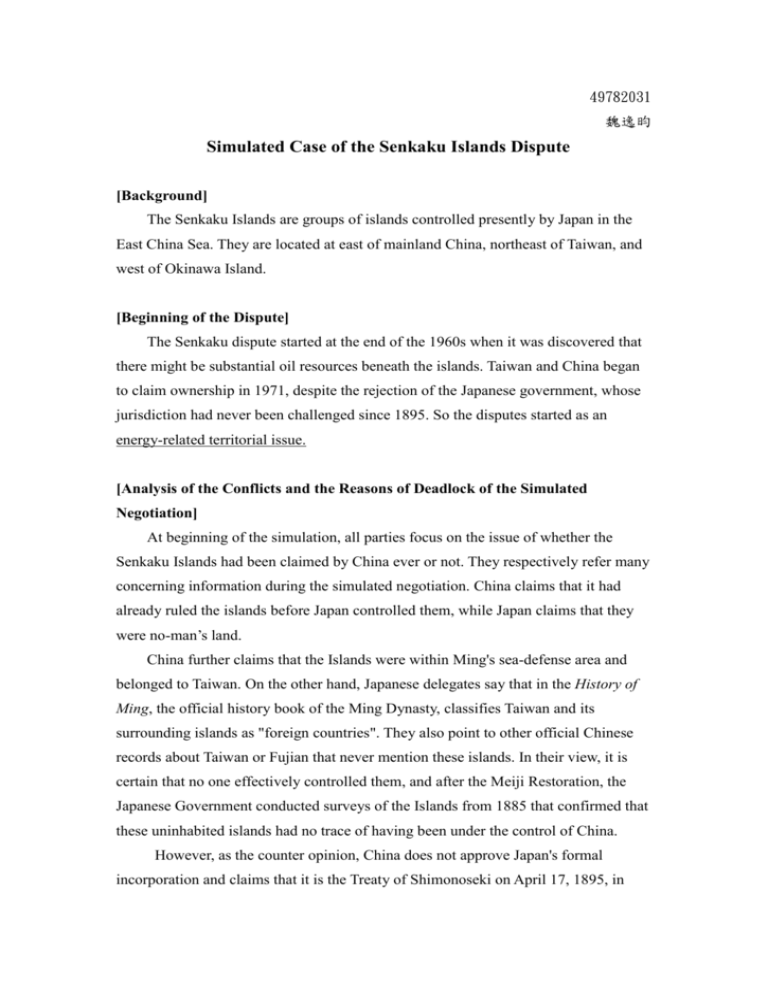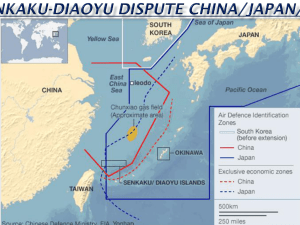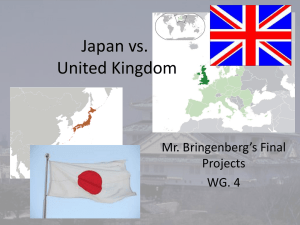Simulated Case of the Senkaku Islands Dispute
advertisement

49782031 魏逸昀 Simulated Case of the Senkaku Islands Dispute [Background] The Senkaku Islands are groups of islands controlled presently by Japan in the East China Sea. They are located at east of mainland China, northeast of Taiwan, and west of Okinawa Island. [Beginning of the Dispute] The Senkaku dispute started at the end of the 1960s when it was discovered that there might be substantial oil resources beneath the islands. Taiwan and China began to claim ownership in 1971, despite the rejection of the Japanese government, whose jurisdiction had never been challenged since 1895. So the disputes started as an energy-related territorial issue. [Analysis of the Conflicts and the Reasons of Deadlock of the Simulated Negotiation] At beginning of the simulation, all parties focus on the issue of whether the Senkaku Islands had been claimed by China ever or not. They respectively refer many concerning information during the simulated negotiation. China claims that it had already ruled the islands before Japan controlled them, while Japan claims that they were no-man’s land. China further claims that the Islands were within Ming's sea-defense area and belonged to Taiwan. On the other hand, Japanese delegates say that in the History of Ming, the official history book of the Ming Dynasty, classifies Taiwan and its surrounding islands as "foreign countries". They also point to other official Chinese records about Taiwan or Fujian that never mention these islands. In their view, it is certain that no one effectively controlled them, and after the Meiji Restoration, the Japanese Government conducted surveys of the Islands from 1885 that confirmed that these uninhabited islands had no trace of having been under the control of China. However, as the counter opinion, China does not approve Japan's formal incorporation and claims that it is the Treaty of Shimonoseki on April 17, 1895, in which China yielded Taiwan to Japan, as well as the islands, although the treaty lacks an explicit mention of them. Thus China claims that they should have been returned together with Taiwan after World War II, under provisions of the Cairo Declaration, Potsdam Declaration, and Article 2 of the San Francisco Treaty and the Treaty of Taipei. Nonetheless, even the contents of the San Francisco Treaty itself regarding Taiwan are sometimes disputed. Actually, I think this simulated negotiation should incorporate the U.S government to negotiate because they play a very important role in the later part of this simulated negotiation. Japan claims that after World War II the islands came under the U.S. occupation as part of Okinawa. The U.S. and the Ryukyu Government under the U.S. occupation explicitly ruled the island, and the U.S. navy used Kuba-jima and Taisho-jima as maneuver areas. In 1972 the islands were returned from the U.S. to Japan as part of Okinawa. Japanese delegates point out that it was not so difficult for Taiwan to occupy these islands in 1945 because they had already incorporated Taiwan and the surrounding islands two months before the U.S. military occupation extended to Yaeyama Islands. Thus they claim that this proves Taiwan’s lack of willingness to own these islands. However, delegates from Taiwan reject Japan's claim, pointing out that the Taiwan government does possess sovereignty over the Islands. When U.S. forces were stationed on Taiwan during the Cold War, military maneuvers were periodically held which required the use of the Islands as a bombing target. Each time, the U.S. military applied to the Taiwan government for authorization, instead of the Japanese authority. According to sources from Taiwan’s delegates, the 1954 ROC-U.S. Mutual Defense Treaty contains wording implying that the Taiwan did control the Islands. The Taiwan government and the U.S. agreed to place under the U.S. forces' patrol the area some miles north of the Taiwan islands, meaning that the Taiwan had agreed to U.S. forces patrolling the area around the Islands. Later on, at the last part of the simulated negotiation, the delegates shift the focus to the resources issue; however, under the very-tightened time limitation, all the three parties cannot make consensus before the negotiation adjourned. [Suggestions of the Best Solutions to the Simulated Negotiation] We all know that sovereignty is a non-negotiable issue. So I suppose all the three parties should less mention sovereignty but the resources, which are the only common ground of the three parties. Just like mentioned in the textbook, “emphasize the interests but don’t focus on the position”. Therefore, view the resources of the Senkaku Islands as a usable economic issue seems to be more negotiable than sovereignty. [Conclusions] However, the one among the three parties that may least agree this should be Japan’s government. While Japan’s legal position seems to be strong thanks to the Treaty of Shimonoseki, it is essential that whether the Japanese government can accept the existence of the Senkaku Islands issue as a subject of dialogue. For example, it is viable to build up a forum as platform for all parties to make proposals on turn the resources to good account. With practical proposals and derived details then, there should be agreements like ECFA or other economic compacts that can resolve this issue. Ultimately, with long-term cooperation and bettered mutual understanding, I suppose our “next generations” will finally find the wisdom to resolve the sovereignty for good. References The Treaty of Shimonoseki The Cairo Declaration The Potsdam Declaration The Article 2 of the San Francisco Treaty The Treaty of Taipei The ROC-U.S. Mutual Defense Treaty The JCP’s 1972 Statement CNN i Report (http://ireport.cnn.com/docs/DOC-517305) Wikipedia (http://en.wikipedia.org/wiki/Senkaku_Islands) Global Security (http://www.globalsecurity.org/military/world/war/senkaku.htm) 中國評論新聞網 (http://www.chinareviewnews.com/doc/1006/7/4/5/100674590.html?coluid=7&kindid =0&docid=100674590) 新台灣新聞週刊 第 640 期








